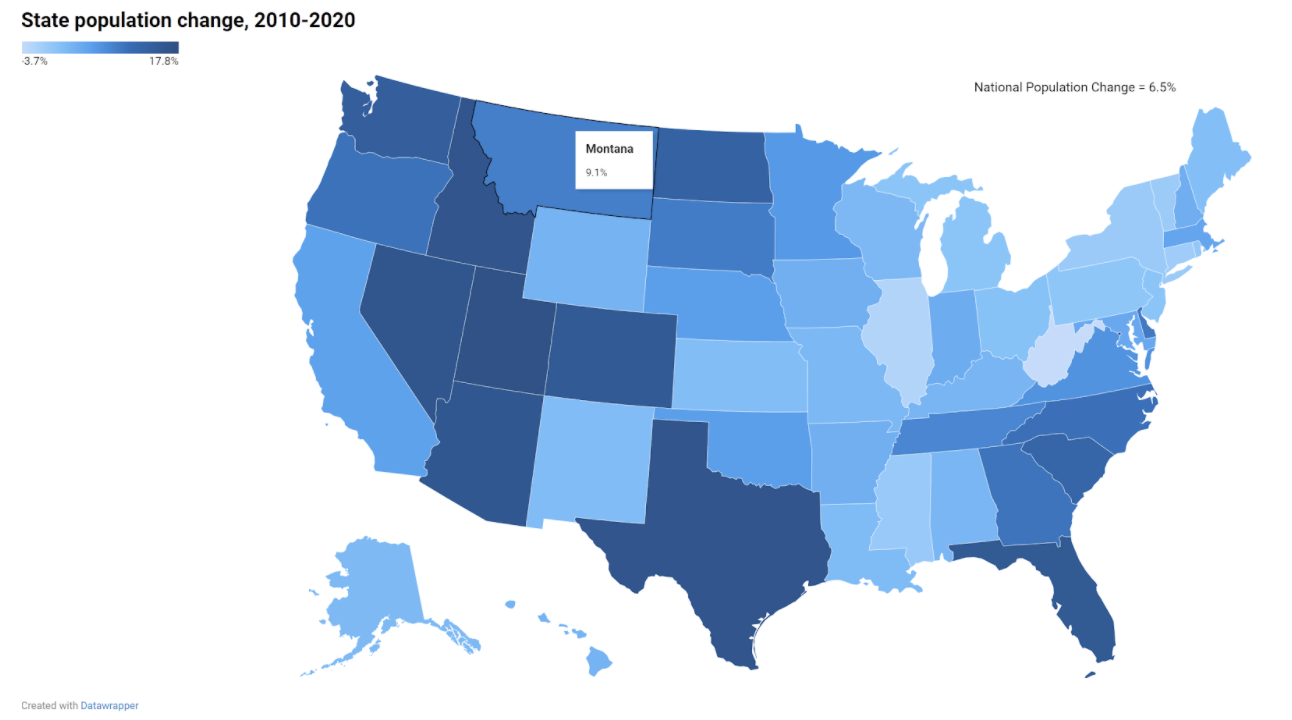By August Benzow
Recently-released population1 estimates through July 2020 show just how uneven population growth was across states from 2010 to 2020. Most Mountain West states surged in population, joined by a few reliably high-growth states in the South and the Pacific Northwest. Meanwhile, every Northeastern state saw population growth below the national average, with the region’s largest state, New York, outright losing population. In the Midwest, only the Dakotas and Minnesota experienced population growth above the national average. On the west coast, California, once a dependable population magnet, saw its growth fall below the national average.
The country’s 10 most populous states experienced diverging fortunes last decade. California’s population trend is the most stark. In a state that saw its population balloon by 10 percent from 2000 to 2010, year-over-year population growth began to nosedive around 2015, and from 2019 to 2020 it saw a 0.2 percent decrease in population. That represents a steeper rate of loss than even states like Vermont and Pennsylvania, which have historically struggled to attract and retain population, and the first time California has outright lost population year-over-year since at least 1990. After experiencing lackluster population growth at the start of the decade, Illinois and New York have steadily lost population for the past few years. In 2020, both states saw their highest rate of year-over-year population loss in the past 30 years.
As international migration and natural population growth slowed nationally over the 2010s, even states that continue to count among the country’s population growth engines are not growing at rates comparable to their historic peaks. Even Florida’s robust population growth rate of 15.3 percent from 2010 to 2020 was lower than its growth rate of 17.4 percent from 20o0 to 2010 and 23.5 percent from 1990 to 2000. Moreover, its 1.1 percent growth rate from 2019 to 2020 was almost half of its decade peak of 2.0 percent growth from 2015 to 2016.
A confluence of trends suggest that the next decade will be a decade of continued population stagnation and decline in many places. A higher mortality rate due to the COVID-19 pandemic alongside a likely decline in birth rates will only exacerbate demographic trends already in play before the pandemic. International migration has experienced an unprecedented decline in the Trump era, with the country’s foreign-born population growing by an anemic 0.5 percent year-over-year in 2018 and 2019. The last decade has also seen worrisome declines in the prime working age population (25-54) in many states as national growth in prime age workers has largely stagnated. The unequal geography of population loss alongside a national slowdown in population growth can further imperil the economic prospects of places that will struggle to see a return to growth post-pandemic. While a future with slower population growth may very well be unavoidable, immigration remains a critical tool for shoring up decline in down but not out communities. A Heartland Visa that would allow economically struggling communities facing low to no population growth to welcome new skilled immigrants has the potential to spur economic growth in such places.
1 In mid-December 2020, the U.S. Census Bureau published July 1, 2020 population estimates. These estimates are not based on the 2020 Census. More information about this dataset can be found here.






